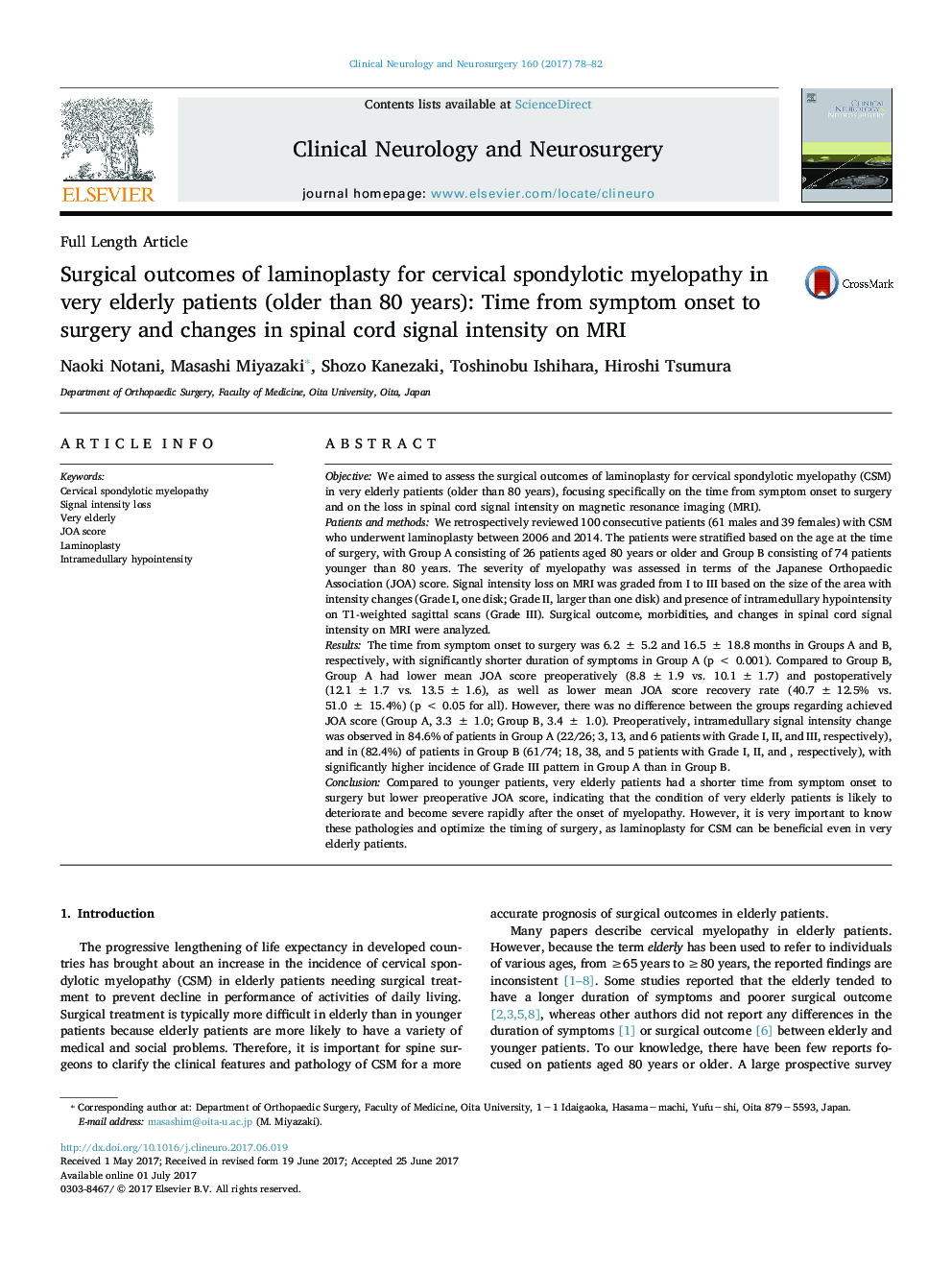| کد مقاله | کد نشریه | سال انتشار | مقاله انگلیسی | نسخه تمام متن |
|---|---|---|---|---|
| 5626946 | 1579662 | 2017 | 5 صفحه PDF | دانلود رایگان |

- The surgical outcomes of laminoplasty for CSM in very elderly patients (older than 80 years) were analyzed.
- The condition of very elderly patients is likely to deteriorate and become severe rapidly after the onset of myelopathy.
- The incidence of Grade III signal intensity was significantly higher among very elderly patients than among younger patients.
- The laminoplasty for CSM can be beneficial even in very elderly patients.
ObjectiveWe aimed to assess the surgical outcomes of laminoplasty for cervical spondylotic myelopathy (CSM) in very elderly patients (older than 80 years), focusing specifically on the time from symptom onset to surgery and on the loss in spinal cord signal intensity on magnetic resonance imaging (MRI).Patients and methodsWe retrospectively reviewed 100 consecutive patients (61 males and 39 females) with CSM who underwent laminoplasty between 2006 and 2014. The patients were stratified based on the age at the time of surgery, with Group A consisting of 26 patients aged 80 years or older and Group B consisting of 74 patients younger than 80 years. The severity of myelopathy was assessed in terms of the Japanese Orthopaedic Association (JOA) score. Signal intensity loss on MRI was graded from I to III based on the size of the area with intensity changes (Grade I, one disk; Grade II, larger than one disk) and presence of intramedullary hypointensity on T1-weighted sagittal scans (Grade III). Surgical outcome, morbidities, and changes in spinal cord signal intensity on MRI were analyzed.ResultsThe time from symptom onset to surgery was 6.2 ± 5.2 and 16.5 ± 18.8 months in Groups A and B, respectively, with significantly shorter duration of symptoms in Group A (p < 0.001). Compared to Group B, Group A had lower mean JOA score preoperatively (8.8 ± 1.9 vs. 10.1 ± 1.7) and postoperatively (12.1 ± 1.7 vs. 13.5 ± 1.6), as well as lower mean JOA score recovery rate (40.7 ± 12.5% vs. 51.0 ± 15.4%) (p < 0.05 for all). However, there was no difference between the groups regarding achieved JOA score (Group A, 3.3 ± 1.0; Group B, 3.4 ± 1.0). Preoperatively, intramedullary signal intensity change was observed in 84.6% of patients in Group A (22/26; 3, 13, and 6 patients with Grade I, II, and III, respectively), and in (82.4%) of patients in Group B (61/74; 18, 38, and 5 patients with Grade I, II, and , respectively), with significantly higher incidence of Grade III pattern in Group A than in Group B.ConclusionCompared to younger patients, very elderly patients had a shorter time from symptom onset to surgery but lower preoperative JOA score, indicating that the condition of very elderly patients is likely to deteriorate and become severe rapidly after the onset of myelopathy. However, it is very important to know these pathologies and optimize the timing of surgery, as laminoplasty for CSM can be beneficial even in very elderly patients.
Journal: Clinical Neurology and Neurosurgery - Volume 160, September 2017, Pages 78-82